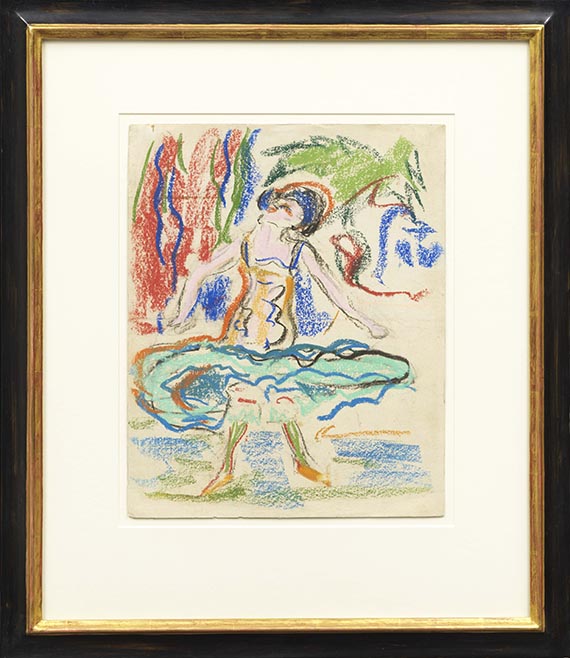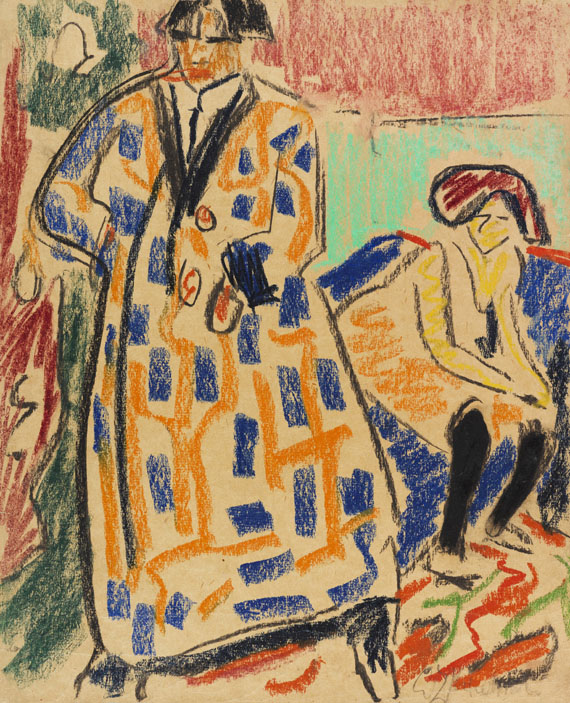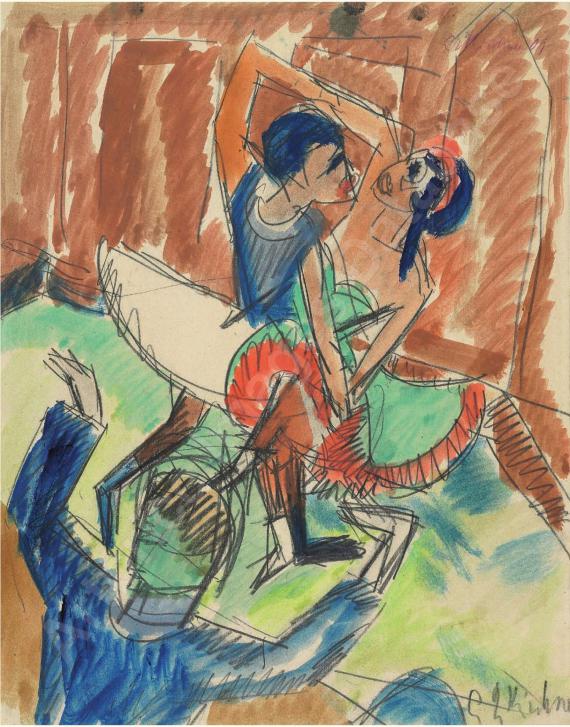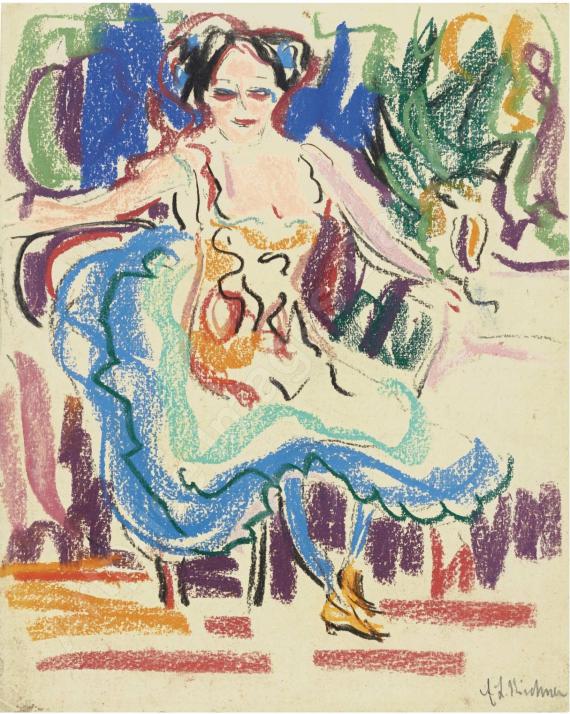20
Ernst Ludwig Kirchner
Kabarett-Tänzerin, Um 1908/09.
Pastel chalks
Estimation: € 180,000 / $ 192,600
Kabarett-Tänzerin. Um 1908/09.
Pastel chalks.
With the estate stamp of the Kunstmuseum Basel (Lugt 1570 b) and the handwritten number “FL Dre / Be 27” on the reverse. On creme cardboard. 43 x 34.5 cm (16.9 x 13.5 in), nearly the full sheet.
• Particularly colorful and elaborate pastel from the Dresden “Brücke” period, in which Kirchner stages the dancer's gyre with incomparable mastery.
• Made right before the iconic painting "Varieté" (c. 1909/10-1926) at the Städel Museum in Frankfurt am Main.
• The interest in dance and movement that he developed in Dresden would ultimately shape Kirchner's entire artistic oeuvre, the painting “Tanz im Varieté” from 1911 in this auction is a prime example thereof.
• An expression of the cultural and social upheaval of the time, the exuberant joie de vivre and newly won freedoms after the turn of the century.
• Two related drawings are at the Sprengel Museum Hanover and the Staatsgalerie Stuttgart.
This work is documented in the Ernst Ludwig Kirchner Archive, Wichtrach/Bern.
PROVENANCE: From the artist's estate (Davos 1938, Kunstmuseum Basel 1946, with the estate stamp on the reverse).
Stuttgarter Kunstkabinett Roman Norbert Ketterer, Stuttgart (1954).
Galerie Rosenbach, Hanover (1986).
Olbricht Collection, Essen/Berlin (acquired in 2003).
EXHIBITION: Ernst Ludwig Kirchner, Kunsthalle Nürnberg, June 20 - September 29, 1991, cat. no. 9 (illu.)
Lebenslust und Totentanz. Olbricht Collection, Kunsthalle Krems, July 18 - November 7, 2010, pp. 131 and 185 (full-page illu.)
Kirchner - Richter - Burgert, me collectors room, Berlin, September 11 - November 3, 2019.
LITERATURE: Lothar-Günther Buchheim, Die Künstlergemeinschaft Brücke, Feldafing 1956 (illu., no. 195).
Stuttgarter Kunstkabinett Roman Norbert Ketterer, Stuttgart, 24th auction, May 29, 1956, p. 58, lot 515 (illu. in b/w, plate 30, erroneously dated “circa 1906”).
Christie's, London, Impressionist & Modern Watercolors & Drawings, Dec. 3, 1985, lot 448 (illu. in color).
Galerie Rosenbach, catalog 31/33, Hanover 1986, cat. no. 46/82 (illu.).
Galerie Gunzenhauser, catalog 10/11, Munich 1987/1988 (illu.).
Lucius Grisebach, E. L. Kirchner 1880-1938, Cologne 1995 (illu.).
Kim Hyang-Sook, Die Frauendarstellungen im Werk von E. L. Kirchner. Verborgene Selbstbekenntnisse des Malers, Marburg 2002 (illu., no. 9).
“Kirchner showed an early tendency to stage motion [..]. He was most fascinated with variety shows and especially with how the dancers moved about."
Erich Heckel about E. L. Kirchner in an art talk with Roman Norbert Ketterer, in: R. N. Ketterer, Dialoge, Stuttgart/Zurich 1988, pp. 41f.
Called up: June 7, 2024 - ca. 17.38 h +/- 20 min.
Pastel chalks.
With the estate stamp of the Kunstmuseum Basel (Lugt 1570 b) and the handwritten number “FL Dre / Be 27” on the reverse. On creme cardboard. 43 x 34.5 cm (16.9 x 13.5 in), nearly the full sheet.
• Particularly colorful and elaborate pastel from the Dresden “Brücke” period, in which Kirchner stages the dancer's gyre with incomparable mastery.
• Made right before the iconic painting "Varieté" (c. 1909/10-1926) at the Städel Museum in Frankfurt am Main.
• The interest in dance and movement that he developed in Dresden would ultimately shape Kirchner's entire artistic oeuvre, the painting “Tanz im Varieté” from 1911 in this auction is a prime example thereof.
• An expression of the cultural and social upheaval of the time, the exuberant joie de vivre and newly won freedoms after the turn of the century.
• Two related drawings are at the Sprengel Museum Hanover and the Staatsgalerie Stuttgart.
This work is documented in the Ernst Ludwig Kirchner Archive, Wichtrach/Bern.
PROVENANCE: From the artist's estate (Davos 1938, Kunstmuseum Basel 1946, with the estate stamp on the reverse).
Stuttgarter Kunstkabinett Roman Norbert Ketterer, Stuttgart (1954).
Galerie Rosenbach, Hanover (1986).
Olbricht Collection, Essen/Berlin (acquired in 2003).
EXHIBITION: Ernst Ludwig Kirchner, Kunsthalle Nürnberg, June 20 - September 29, 1991, cat. no. 9 (illu.)
Lebenslust und Totentanz. Olbricht Collection, Kunsthalle Krems, July 18 - November 7, 2010, pp. 131 and 185 (full-page illu.)
Kirchner - Richter - Burgert, me collectors room, Berlin, September 11 - November 3, 2019.
LITERATURE: Lothar-Günther Buchheim, Die Künstlergemeinschaft Brücke, Feldafing 1956 (illu., no. 195).
Stuttgarter Kunstkabinett Roman Norbert Ketterer, Stuttgart, 24th auction, May 29, 1956, p. 58, lot 515 (illu. in b/w, plate 30, erroneously dated “circa 1906”).
Christie's, London, Impressionist & Modern Watercolors & Drawings, Dec. 3, 1985, lot 448 (illu. in color).
Galerie Rosenbach, catalog 31/33, Hanover 1986, cat. no. 46/82 (illu.).
Galerie Gunzenhauser, catalog 10/11, Munich 1987/1988 (illu.).
Lucius Grisebach, E. L. Kirchner 1880-1938, Cologne 1995 (illu.).
Kim Hyang-Sook, Die Frauendarstellungen im Werk von E. L. Kirchner. Verborgene Selbstbekenntnisse des Malers, Marburg 2002 (illu., no. 9).
“Kirchner showed an early tendency to stage motion [..]. He was most fascinated with variety shows and especially with how the dancers moved about."
Erich Heckel about E. L. Kirchner in an art talk with Roman Norbert Ketterer, in: R. N. Ketterer, Dialoge, Stuttgart/Zurich 1988, pp. 41f.
Called up: June 7, 2024 - ca. 17.38 h +/- 20 min.
Around 1909, amid the Dresden “Brücke” years, Kirchner's fascination with dance found its way into his oeuvre in the form of drawings, prints, and paintings of dancers, in which he explored the world of the cabaret, dance, and movement, creating significant motifs up into his late period in the 1930s.
Kirchner made his first sketches of performances on visits to dance cafés and nightclubs such as 'Central Theater' or 'Victoria Salon'. In his studio, the artist developed the sketches into elaborate compositions that were no less dynamic and animated.
The pastel offered here captivates us with the realism of the almost immaterial play of lines, hatching, and colors. Kirchner sees the dancer's body in a fading climax of movement: a pause between the rise and fall of tension, that brief moment in which the dance movement comes to completion. The dancer pauses for just a small, imperceptible moment and seems to float on the stage, as if time stood still.
Dance in general, but erotic dance in particular fascinated Kirchner. Physical vitality reveals itself to the observer in an unadulterated way. In the fast-paced movement, the dancer's skirt is lifted, showing her ruffled underwear. The stage is meticulously outlined with just a few sketched props. Kirchner united the dance performance in a fervent rhythm of colors, giving viewers a feeling of being part of the exciting evening with elegant dance and throbbing music. Kirchner not only paid homage to dance performances with this grainy, brittle pastel and color chalk drawing, but he made further drawings of this dancer in a similar, rapid style, elaborating the dancer's demanding choreographic poses on paper. Finally, the experience sketched on site can also be found in the grand painting “Varieté (English Dancing Couple)” (c. 1909/10-1926, Städel Museum, Frankfurt am Main), in which the dancer is elegantly led across the stage by her partner. [MvL/CH]
Kirchner made his first sketches of performances on visits to dance cafés and nightclubs such as 'Central Theater' or 'Victoria Salon'. In his studio, the artist developed the sketches into elaborate compositions that were no less dynamic and animated.
The pastel offered here captivates us with the realism of the almost immaterial play of lines, hatching, and colors. Kirchner sees the dancer's body in a fading climax of movement: a pause between the rise and fall of tension, that brief moment in which the dance movement comes to completion. The dancer pauses for just a small, imperceptible moment and seems to float on the stage, as if time stood still.
Dance in general, but erotic dance in particular fascinated Kirchner. Physical vitality reveals itself to the observer in an unadulterated way. In the fast-paced movement, the dancer's skirt is lifted, showing her ruffled underwear. The stage is meticulously outlined with just a few sketched props. Kirchner united the dance performance in a fervent rhythm of colors, giving viewers a feeling of being part of the exciting evening with elegant dance and throbbing music. Kirchner not only paid homage to dance performances with this grainy, brittle pastel and color chalk drawing, but he made further drawings of this dancer in a similar, rapid style, elaborating the dancer's demanding choreographic poses on paper. Finally, the experience sketched on site can also be found in the grand painting “Varieté (English Dancing Couple)” (c. 1909/10-1926, Städel Museum, Frankfurt am Main), in which the dancer is elegantly led across the stage by her partner. [MvL/CH]
20
Ernst Ludwig Kirchner
Kabarett-Tänzerin, Um 1908/09.
Pastel chalks
Estimation: € 180,000 / $ 192,600
Commission, taxes et droit de suite
Cet objet est offert avec imposition régulière ou avec imposition différentielle.
Calcul en cas d'imposition différentielle:
Prix d’adjudication jusqu’à 800 000 euros : frais de vente 32 %.
Des frais de vente de 27% sont facturés sur la partie du prix d’adjudication dépassant 800 000 euros. Ils sont additionnés aux frais de vente dus pour la partie du prix d’adjudication allant jusqu’à 800 000 euros.
Des frais de vente de 22% sont facturés sur la partie du prix d’adjudication dépassant 4 000 000 euros. Ils sont additionnés aux frais de vente dus pour la partie du prix d’adjudication allant jusqu’à 4 000 000 euros.
Le prix de vente inclut la taxe sur la valeur ajoutée, actuellement de 19%.
Calcul en cas d'imposition régulière:
Prix d'adjudication jusqu'à 800 000 € : 27 % de commission majorée de la TVA légale
Prix d'adjudication supérieur à 800 000 € : montants partiels jusqu'à 800 000 € 27 % de commission, montants partiels supérieurs à 800 000 € : 21 % de commission, à chaque fois majorés de la TVA légale.
Prix d'adjudication supérieur à 4.000 000 € : montants partiels supérieurs à 4.000 000 € : 15 % de commission, à chaque fois majorés de la TVA légale.
Si vous souhaitez appliquer l'imposition régulière, merci de bien vouloir le communiquer par écrit avant la facturation.
Calcul en cas de droit de suite:
Pour les œuvres originales d’arts plastiques et de photographie d’artistes vivants ou d’artistes décédés il y a moins de 70 ans, soumises au droit de suite, une rémunération au titre du droit de suite à hauteur des pourcentages indiqués au § 26, al. 2 de la loi allemande sur les droits d’auteur (UrhG) est facturée en sus pour compenser la rémunération liée au droit de suite due par le commissaire-priseur conformément au § 26 UrhG. À ce jour, elle est calculée comme suit :
4 pour cent pour la part du produit de la vente à partir de 400,00 euros et jusqu’à 50 000 euros,
3 pour cent supplémentaires pour la part du produit de la vente entre 50 000,01 et 200 000 euros,
1 pour cent supplémentaire pour la part entre 200 000,01 et 350 000 euros,
0,5 pour cent supplémentaire pour la part entre 350 000,01 et 500 000 euros et
0,25 pour cent supplémentaire pour la part au-delà de 500 000 euros.
Le total de la rémunération au titre du droit de suite pour une revente s’élève au maximum à 12 500 euros.
Calcul en cas d'imposition différentielle:
Prix d’adjudication jusqu’à 800 000 euros : frais de vente 32 %.
Des frais de vente de 27% sont facturés sur la partie du prix d’adjudication dépassant 800 000 euros. Ils sont additionnés aux frais de vente dus pour la partie du prix d’adjudication allant jusqu’à 800 000 euros.
Des frais de vente de 22% sont facturés sur la partie du prix d’adjudication dépassant 4 000 000 euros. Ils sont additionnés aux frais de vente dus pour la partie du prix d’adjudication allant jusqu’à 4 000 000 euros.
Le prix de vente inclut la taxe sur la valeur ajoutée, actuellement de 19%.
Calcul en cas d'imposition régulière:
Prix d'adjudication jusqu'à 800 000 € : 27 % de commission majorée de la TVA légale
Prix d'adjudication supérieur à 800 000 € : montants partiels jusqu'à 800 000 € 27 % de commission, montants partiels supérieurs à 800 000 € : 21 % de commission, à chaque fois majorés de la TVA légale.
Prix d'adjudication supérieur à 4.000 000 € : montants partiels supérieurs à 4.000 000 € : 15 % de commission, à chaque fois majorés de la TVA légale.
Si vous souhaitez appliquer l'imposition régulière, merci de bien vouloir le communiquer par écrit avant la facturation.
Calcul en cas de droit de suite:
Pour les œuvres originales d’arts plastiques et de photographie d’artistes vivants ou d’artistes décédés il y a moins de 70 ans, soumises au droit de suite, une rémunération au titre du droit de suite à hauteur des pourcentages indiqués au § 26, al. 2 de la loi allemande sur les droits d’auteur (UrhG) est facturée en sus pour compenser la rémunération liée au droit de suite due par le commissaire-priseur conformément au § 26 UrhG. À ce jour, elle est calculée comme suit :
4 pour cent pour la part du produit de la vente à partir de 400,00 euros et jusqu’à 50 000 euros,
3 pour cent supplémentaires pour la part du produit de la vente entre 50 000,01 et 200 000 euros,
1 pour cent supplémentaire pour la part entre 200 000,01 et 350 000 euros,
0,5 pour cent supplémentaire pour la part entre 350 000,01 et 500 000 euros et
0,25 pour cent supplémentaire pour la part au-delà de 500 000 euros.
Le total de la rémunération au titre du droit de suite pour une revente s’élève au maximum à 12 500 euros.




 Lot 20
Lot 20 



